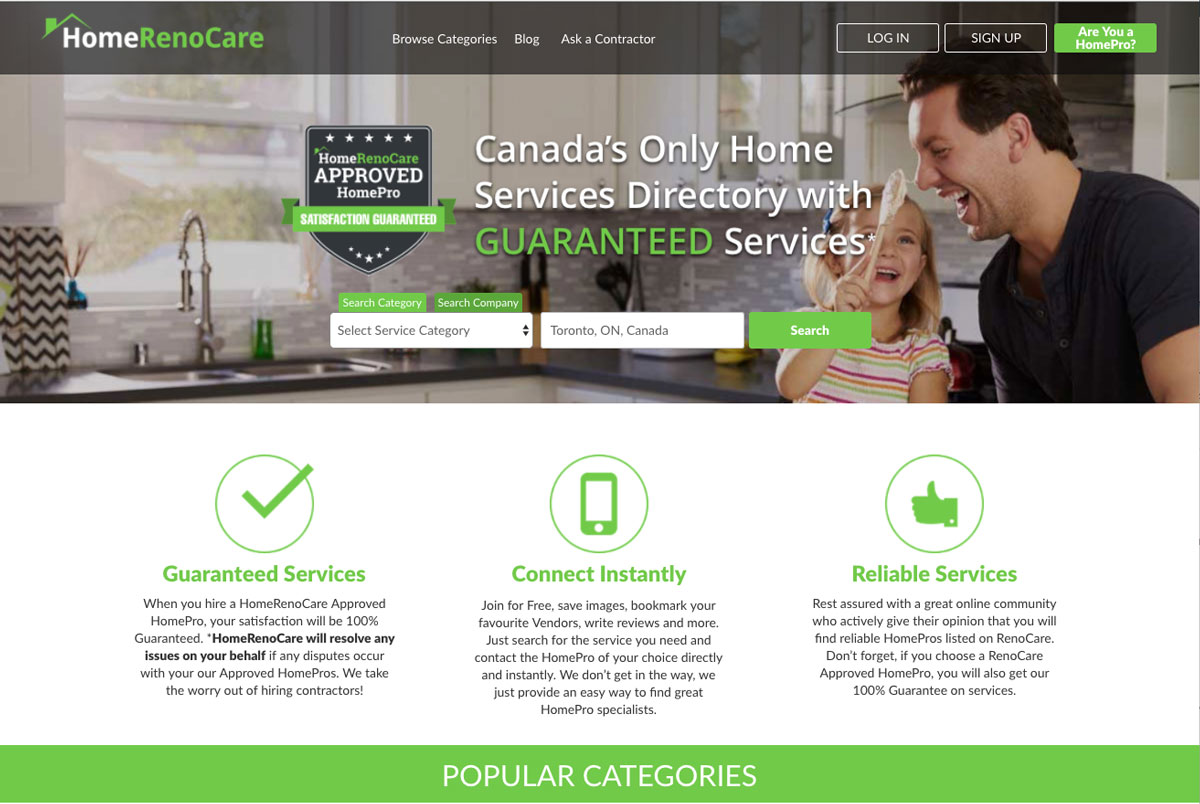
by DG | Nov 5, 2017 | Online Marketing
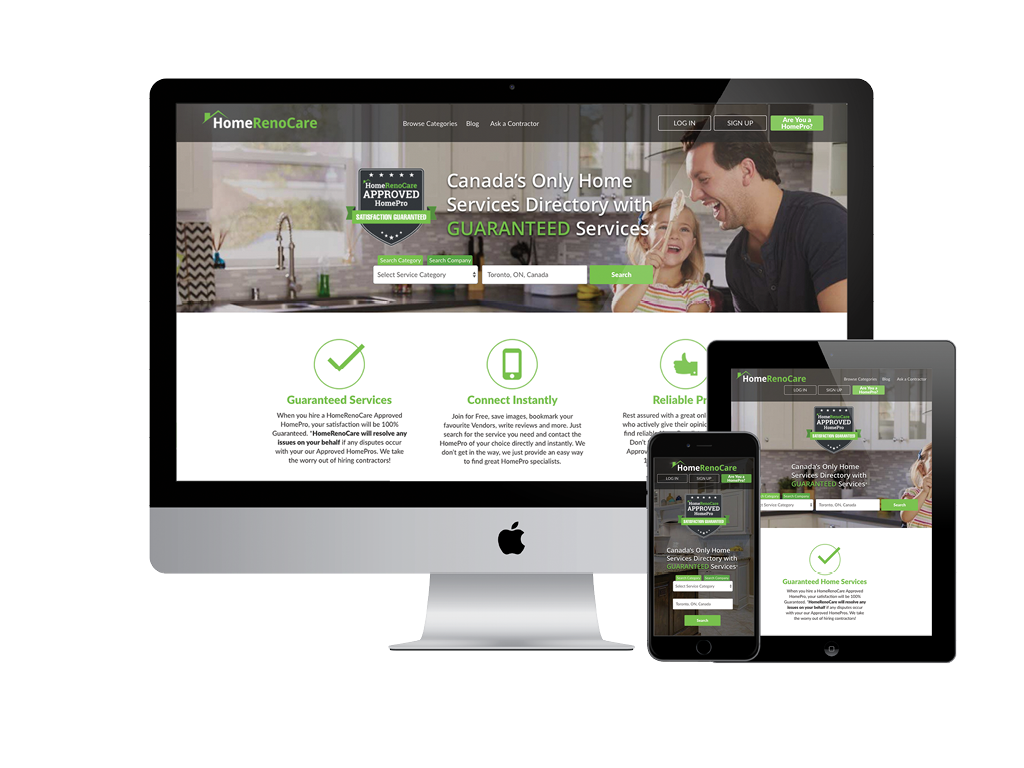
Check out one of our latest projects HomeRenoCare.com .
It’s a web application that we built from scratch that serves up listing of home service companies.
It’s Canada’s only Home Services Directory with GUARANTEED Services. HomeRenoCare Approved Professionals are reputable high-quality service providers. If there is any dispute we will mediate to resolve the issue on the customers behalf.

by DG | Aug 21, 2017 | Online Marketing
Creating an online marketing strategy to get more customers can be a great step for your business. But creating an online marketing strategy that will help you consistently bring in and keep customers can help you keep your business going for the long run. For tips on creating an online marketing strategy that will work for the future of your business, check out what members of the online small business community have to say.
Use These Essential Elements for Your Inbound Marketing Strategy
There’s a lot that goes into creating a successful inbound marketing strategy. But there are some factors that are absolutely essential, like the nine elements mentioned in this post by Joanne Chong on the RankReveal blog.
Learn About Conversions to Get More of Them
When it comes to making sales, conversions are paramount. But there are different types of conversion strategies to consider. In this Kissmetrics post, Sherice Jacob outlines the different types and explains why they matter so you can create a strategy to improve your own conversion rates.
Write Better Content with These Pro Tips
Content marketing can be a powerful way to attract potential customers. But you need your content to be powerful if you want actual results. This Digital Current post by Rebekah Radice includes some tips from the pros about writing better content. And members of the BizSugar community shared thoughts on the post here.
Develop a Powerful Social Chain
If you are able to build powerful social connections online, you can improve your chances of making constant sales for your business. This post by Pamela Swift on Getentrepreneurial.com includes information about building a powerful social chain for your small business.
Consider the Top Email Marketing Tools for Your Business
Email marketing is an essential part of any ongoing online marketing strategy. But there are plenty of different solutions to consider. Vinay Patankar compares some of the top options in this Process Street post.
Decrease Your Ad Spend Without Compromising Results
Paid advertising can provide a major boost to your online marketing efforts. But it can also get expensive. In this post, Neil Patel shares an insider’s guide for how you can decrease your ad spend by more than half.
Use Mobile Marketing to Elicit Behavior Change
Mobile technology has changed the landscape of online marketing. And it can also help you elicit specific behaviors from potential customers when used properly, as this Noobpreneur post by Ivan Widjaya explains.
Test and Perfect Your PPC Strategy
Making the most of PPC advertising can take some trial and error. But if you know how to test different approaches, you can perfect your own strategy. Learn more in this Search Engine Land post by Andreas Reiffen.
Use Tailored Tweets to Find Relevant Content
Twitter isn’t just a great marketing tool. It can also help you find content that’s relevant to your business. And tailored tweets is a feature that can help, according to this Inspire to Thrive post by Lisa Sicard. You can also see commentary on the post over on BizSugar.
Get an Endless Supply of Blog Post Ideas
If you use blogging as part of your online marketing strategy, you might sometimes find it difficult to come up with new ideas. But you can consistently come up with new ideas using the tips in this DIY Marketers post by Marsha Kelly.
If you’d like to suggest your favorite small business content to be considered for an upcoming community roundup, please send your news tips to:
Online Shoppers image via Shutterstock
More in: Content Marketing8 Comments ▼
https://smallbiztrends.com/2017/07/10-tips-creating-online-marketing-strategy-will-consistently-bring-customers.html
On – 29 Jul, 2017 By Annie Pilon
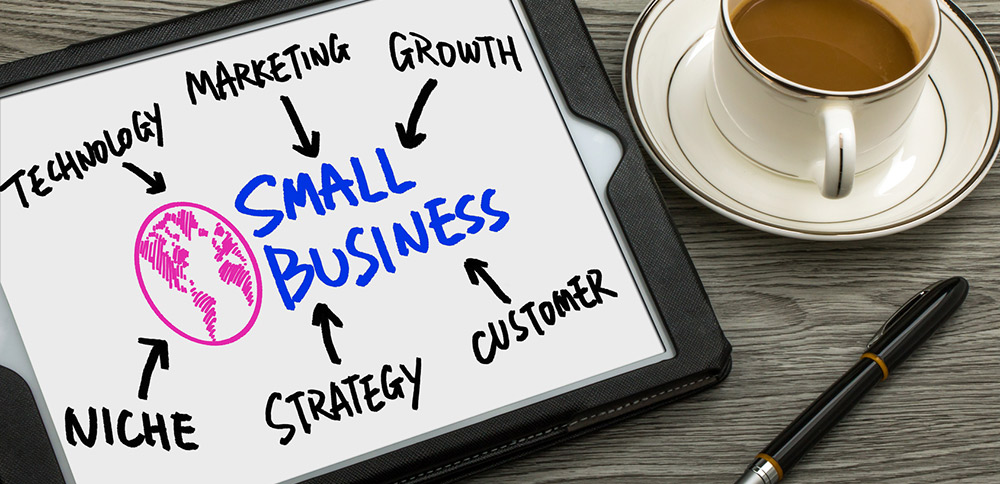
by DG | Mar 22, 2020 | Online Marketing
Take your marketing efforts to the next level with these innovative ideas! We’re sharing the 11 best ideas for small business marketing in this post.
Updated March 22, 2020
Marketing is the bread and butter of every small business.
Unfortunately, many companies often overlook its importance, believing they don’t have the budget for it.
This is a massive mistake. There are many affordable ways to promote your business online and offline. Don’t just take our word for it. Check out 11 innovative ideas for a small business.
1. Become More Social
One of the most powerful marketing tools is also one of the most affordable marketing tools.
What are we talking about? Social media marketing, of course.
If you want to stand out in the market, you must aim to create small business accounts on social media. Don’t follow the norm. Focus on developing an online presence that’s full of personality. What could help you stand out from the crowd? Could it be unique competitions? Breathtaking photographs? Funny memes? Your tone of voice?
There are many different social media networks that can provide free marketing. For instance, create and maintain pages on Facebook, Twitter, Pinterest, YouTube, and Instagram. Google+ is also ideal for small business, as it provides special local features in Google, such as improved address listings and contact details.
Think about a USP, services, and the customer to create unique ideas for small businesses. Offer discounts, VIP offers, and competitions that will encourage engagement. Don’t forget to use your tone of voice to reinforce your brand.
2. An Active Blog
The one thing letting your marketing efforts down could be your website.
Your website should offer so much more than your contact details and a business summary. When used well, your website can become your company’s most valuable asset. Offer superb content to the customer with an active blog, which can provide many benefits to your brand. Aim to become a thought leader who provides reliable industry resources.
Some of the blog ideas for a small business you can write include:
- Industry news stories
- Company news
- How-tos
- Listicles
- Opinion pieces
Don’t forget to incorporate high-quality, professional images within each article, too. What’s more, you should develop a unique tone of voice that complements your brand.
Blog content can also help turn a lead into a conversion. Integrate calls to actions to direct them to a product page, which can boost your profit margin. The more content you create, the more people will discover your website – which will improve sales. You can even promote your articles across social media to drive traffic to your site.
3. Paid Social Media
If you have next to no budget, organic social media leads can be an ideal solution. Yet, if you do have a little money to play with for a marketing budget, you should consider paid social media.
If you have some great ideas for a small business, it can be a great way to showcase them to a wider audience. The likes of Facebook Advertising, Instagram, and Twitter will allow you to pay for sponsored posts. You can set the budget (it could be as little as $10) and you can also target the post to your demographic. For instance, if your target market is 18-25-year-old females, you can target the age range and gender. This way, you don’t have to worry about the marketing message becoming lost in the crowd.
4. Online Reviews
Unfortunately, many businesses overlook the many benefits of online reviews.
One of the biggest reasons they may not use reviews is because they’re scared about what they may read. Yet, if you offer a great product and a great service, online reviews should be a no brainer. Forrester stated trust is the most critical aspect of brand development and maintenance.
Online reviews can encourage trust in a brand and products. Potential customers can gain an insight into your services by reading impartial reviews. If you have glowing reviews, they’re more likely to choose you over a competitor.
5. Respond to Reviews
Don’t set up an online review profile and think your job is done. You must aim to respond to every positive and negative review.
It will prove to potential customers that you’re responsive. It will also make previous customers feel valued. It will display your dedication to exceptional customer service. There will be a time when you receive a bad review. Every large or small business will receive one at some point. It’s how you handle the bad review that can encourage trust in your brand. Reviews will impact a buyer’s decision. If you apologize for a bad experience and aim to rectify the mistake, people will trust in your brand a little more.
6. Ask Your Happy Customers to Write a Review
Want to receive positive reviews from happy customers?
During the checkout process, ask them if they have had a positive experience at a hotel or store. If they offer a positive response, ask them politely to write an online review.
You can guarantee a happy customer will want to help you if they can. If you don’t want to ask the customer, consider making the request with a follow-up email.
7. Free Publicity
The best publicity is free publicity, right?
Does that sound easier said than done? Well, it doesn’t have to be. For instance, you can host a charity event that garners the attention from the press.
You could also invite the media to grand openings or event days, who may feature the event in print or online. What’s more, if you’re a thought leader, you should connect with editors or journalists. When an industry news story arises, you could become the voice on the subject of a feature or news article. It’s a great way to showcase your brand and it won’t cost you a penny to do so.
8. Create a Brochure
Are you looking for offline ideas for a small business?
Create a brochure that showcases your brand, product, and services. For instance, if you offer renovation services, you can create a stunning brochure to feature both in the hotel rooms and the lobby. You can also ask other local businesses to promote the brochures to their customers, too.
9. Get Involved in the Local Community
Looking for local ideas for small businesses? You need to get involved in the community. Think about the many ways you can connect with your neighbors whilst promoting a brand.
It’s a great method to generate a buzz around your business whilst helping a local area. For instance, you could sponsor a local sports team or event. What’s more, you could collaborate with other local brands to cross-promote your services. It’s a superb way to come up with new and exciting ideas for a small business. For instance, you could showcase each other’s products on social media channels. This will allow you to reach a whole new audience and customer base.
If working with other companies isn’t an option, consider taking part in craft or food fairs. You could also host a local fundraiser or get the whole team to volunteer on a community project.
10. Ask for Referrals
Sometimes the best way to receive referrals is by asking for them. If you have a satisfied customer, why not ask them to refer other businesses and entrepreneurs to you?
It’s important to remember that people often enjoy helping other people. For instance, if a happy client no longer needs your services, ask for them to join you for a final meeting. Here you can cross the t’s and dot the eyes, and it’s also an excellent opportunity to ask for a referral. The worst they can say is “no” – so what do you have to lose? It could turn out to be one of the most profitable ideas for a small business on this list.
11. Call-to-Action Ideas for a Small Business
It’s believed more than half of website visitors abandon a web page in less than 15 seconds.
If you have a low conversion rate, this could be the reason why – so take a look at your bounce rate. One of the best ways to boost conversions and capture attention is with a call-to-action. It’s a brilliant way to encourage a potential customer to take action on your site. It instantly tells a customer what the page is about and how they can order a product or service.
The best call-to-actions are clear and simple and should encourage instant action.
For instance, the following words work well in a call-to-action:
- Start
- Learn
- Discover
- Free
- Build
- Stop
- Save
- Try
It might be the difference between them buying with you or losing them to a competitor. For this reason, it could be one of the best conversion ideas for a small business.
Conclusion
Some or all the ideas for a small business can help propel your company to a new range of customers.
You don’t have to be a big company with a large marketing team to become the competition. It’s important to look for ideas and marketing tools to help you affordably boost your reach. As a result, you could receive improved engagement and conversions.
The goal is to be as creative as possible. A little hard work will also help you stand out from both your large and small rivals.
Do you want to learn more about how we can help your business grow? Click here to contact us to get started with some marketing ideas for your small business. We were selected as one of the Top Small Business Web Design Companies. See the designrush agency listings.

by DG | Jul 18, 2017 | Online Marketing
[Editor’s Note: Please join me in welcoming Anne Leuman to TopRankBlog.com. Anne is a Copywriter that joined TopRank Marketing earlier this year and specializes in creating awesome B2B content for some of our amazing Enterprise clients.]
I’d venture to guess that you’re no stranger to content marketing. Content Marketing Institute reports that 89% of all organizations use content in their marketing efforts. But is content your main driver of growth? It might not be, and that’s okay, but we’re here to show you how successful content can be.
Take a look at startups for example. Startups are known for viral growth. To attract or keep investors, they need to grow at staggering rates. So how do they do it? A lot of them rely on content marketing. And with good reason.
There is no denying that content marketing is one of the most cost effective marketing tactics. In fact, Demand Metric reports that content marketing costs 62% less than traditional marketing and generates three times the leads. Yet, 52% of companies don’t have a formal content strategy.
If you’re looking to double down on your content strategy, see how these seven startups skyrocketed to success with content:
It’s hard to imagine HubSpot as a startup, but back in 2006 they were a fresh-faced business. And they grew on the back of quality, innovative content. They earn our #1 spot because over 75% of their generated leads come from content.
HubSpot accomplished this by offering free white papers, case studies, eBooks, and webinars, and hiding them behind a form. In order for visitors to get the free content, they had to provide their information and become a lead. In addition, HubSpot added a call to action at the bottom of every blog post. An action that tripled the amount of leads generated by their blog, according to HubSpot CMO Mike Volpe.
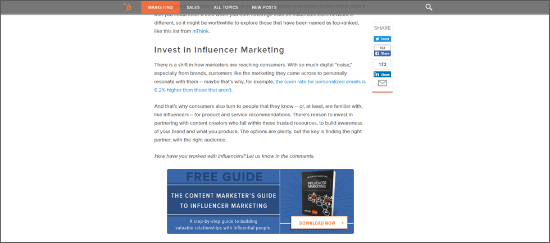
Blue Apron, an ingredient and recipe delivery service, grew 500% in 2015. And they attributed that success to their content marketing strategies.
Blue Apron wanted to get subscribers excited about recipes before they showed up at their door, creating a more satisfying product experience. To do this, they created educational, fun cooking content including recipe histories, cooking techniques, and kitchen timesavers. With this method, they have engaged over 1.7 million Facebook fans to date.
Beyond engaging a larger audience and creating a better experience, educational content allowed Blue Apron to form more meaningful relationships with their subscribers. They became the go-to source for anything kitchen related, building trust and loyalty among their customers.
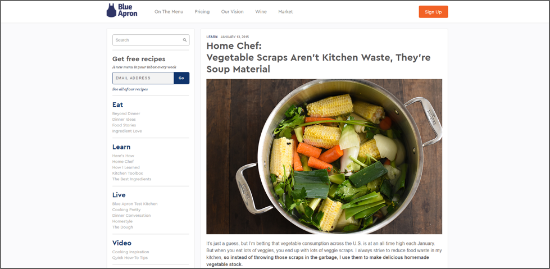
Content put the pressure on Mint’s competitors. When Mint, a personal finance app, started in 2007, blogging wasn’t widely adopted by companies. And if they did adopt it, they weren’t blogging often. Mint created the MintLife blog and steadily produced finance tips, videos, and news roundups. This gave Mint a competitive edge and allowed them to rank on search engines ahead of market leaders—including ranking number one for personal finance.
Oh, and this all happened before the launch of their product. With this strategy, they were able to have 20,000 subscribers before releasing their application. This allowed them to drive substantial traffic to the app on launch day. By 2009, Mint would be purchased by Intuit for $170 million. An achievement partially credited to their content strategy.
Buffer, one of the most widely used social media tools today, was launched with content. At first, they pitched their app to well-known blogs and media outlets, hoping they would write about the tool and gain a large audience. But the big players turned them down. This forced their founder, Leo Widrich, to try gaining an audience another way.
Leo started guest blogging. He wrote over 150 posts on social media and published them on numerous blogs. By creating guest blogging relationships, Buffer gained the audience of other blogs and grew to 100,000 users in just 10 months. Guest blogging was the strategy that gave them the most initial growth.
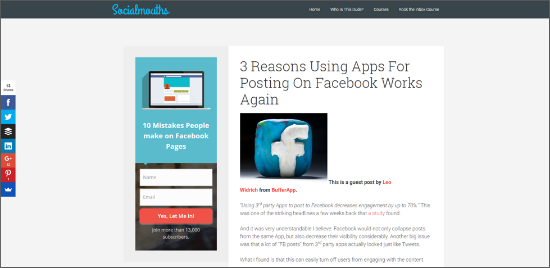
Imagine if your first 1,200 customers were generated solely by content. That was the case for Design Pickle and its founder Russ Perry.
Design Pickle was created to make graphic design a more convenient and available service. They started a subscription service where subscribers could receive unlimited graphic design help for one easy, flat rate.
Perry’s launch strategy centered around employing guest blogging. Russ wrote blog posts on marketing and design and posted them on affiliate blogs. Inside each post, Russ was able to offer promotions and information about his services. With this strategy, Design Pickle was able to capture their first 1,200 customers. They have now served over 100,000 project requests.
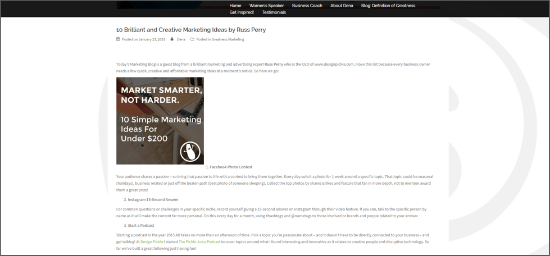
KISSmetrics, a marketing analytics platform, is one of the most popular marketing brands today. But it was a struggle to get it off the ground in 2008. Hiten Shah, co-founder of KISSmetrics, attributes their initial success to content curation and the new (at the time) microblogging platform, Twitter.
Blogging wasn’t popular when KISSmetrics was getting started—they didn’t even have one. So how did they gain an audience? They used curated content from Twitter and hashtags to reach large audiences and gain a following. Hiten says, “Sharing other marketers’ content was the perfect way to spread goodwill, promote great content, and build our own Twitter audience.” Eventually, their website was beaming with Twitter referrals. Since then, KISSmetrics has evolved to become blogging experts, with blogs accounting for over 70% of their leads and 82% of their website traffic.
Experts in all things beauty, Glossier started out as a beauty blog called Into The Gloss, which still exists today. But it quickly grew into something more. Known for providing great advice from real women—Into The Gloss, started by Emily Weiss—was one of the largest skincare and makeup blogs. With a passion for beauty and a captive audience, Emily decided to use her blog to launch her own beauty line.
In writing her blog, Emily already had all of the market research she needed and began producing skincare and makeup products. She then directly involved Into The Gloss’s audience in her new venture by teasing her new brand, Glossier, and documenting the process. By the time she officially launched, Glossier had 15,000 followers who didn’t even know what it was. Her stellar content and engaged audience (including 500,000 Instagram followers) allowed her blog to turn into a successful retailer.

Implementing content marketing and doing it well has the power to propel your business to success. The (former) startups above are a testament to that. Check out these 10 infographics to elevate your content marketing even further.
http://www.toprankblog.com/2017/06/success-content-marketing/
On – 27 Jun, 2017 By Anne Leuman

by DG | Apr 28, 2017 | Online Marketing
Content marketing can be one of the most effective strategies for organizations that want to build engaged audiences and garner long-term marketing wins, but the intricacies of content marketing can be intimidating, particularly if you’re working with a small or underbudgeted team.
However, whether you’re focused on building a content strategy, creating and distributing content, or measuring content performance, even one-person teams can successfully implement content marketing.
How? Setting expectations, contracting with outside help, and staying the course with your content strategy can help you achieve big content wins even with small teams.
1. Set expectations (and benchmarks)
Content marketing is ultimately a long-term strategy. Though some content can garner early brand-awareness and audience-building wins, you don’t typically see the same immediate results or measurable returns that you would with pay-per-click advertising or email marketing, for example.
For small organizations that have limited brand awareness or audiences, content marketing can take 6-18 months to bear fruit. For these organizations, the key to creating big wins is to think months ahead and to set realistic performance expectations as part of their content strategy.
Start by assessing your current content marketing performance to create a benchmark for your ongoing efforts.
To collect insight on your website, mobile, and social channels, use Google Analytics, Simply Measured, Mixpanel, or other analytics platforms.
Also use tools such as Ahrefs, Moz, and SEMrush to monitor keyword rankings, SEO, and general search visibility metrics; moreover, to benchmark email effectiveness, look at data from your email service or automation providers, such as Marketo, MailChimp, and VerticalResponse.
After assessing the performance of your current marketing channels, collect these metrics in a spreadsheet. Those metrics could include the following:
- Web traffic, time on site, bounce rate, unique visitors, return visitors, etc.
- Social traffic, shares, comments, mentions, and other engagement metrics.
- Email audience growth, open rate, bounce rate, CTA clicks, etc.
- Keyword rank, organic traffic, etc.
If your team hasn’t invested in marketing, email, or analytics software, you will have to log your metrics manually by grabbing social information from the social platforms themselves, collect blog information from WordPress or other CMS, and so on.
Setting benchmarks is important to understand what type of results you can realistically expect from your content marketing and for identifying high-performing content down the road.
2. Contract outside resources
The reality of working with a small team is that there is a mountain of tasks to accomplish and only so much time in the day. Compound those pressures with performance expectations and the need to maintain content quality standards, and you have the recipe for a stressful working environment.
For small teams to achieve big wins, they must remain focused on their larger content strategy and experiment with outside resources, such as freelancers and agencies, and contracted employees.
The key is to find resources that help your team directly execute content that aligns with your content strategy; to keep a lean team and respect your budgetary constraints, immediately cut anyone who doesn’t fit.
To find success with freelancers or an agency, you must set them up for success:
- Provide clear performance expectations.
- Share brand style guides, contributor guidelines, goals, and other relevant marketing team activities.
- Organize your marketing programs to avoid confusion.
- Concentrate on transparent communication to create win-win scenarios.
Outside resources can make small marketing teams more effective by adding more hands on deck, diversifying the expertise on the team, and providing flexible resources that can be used to scale; the challenge is to build long-term working relationships that can keep costs low.
Small teams must aim to create repeat engagements with outside resources to…
- Execute content more efficiently while maintaining quality standards
- Remain more agile and flexible in their content efforts
- Avoid costly onboarding and industry training time
- Eliminate the need for a W2 hire and cut down on HR costs
Overall, freelancers and agencies can be your secret weapon to highly effective marketing teams. And, if managed well and tactfully, they can be a more budget-friendly option than internal hires.
3. Stay the course
Since content marketing is a marathon strategy, the key to achieving big results is to consistently experiment with new content campaigns, concentrate on building terrific brand experiences, and grow your audience and community over time.
In 2016, fully 70% of B2B marketers rated their content strategy more effective than in the previous year—a testament to their ongoing and evolving content efforts.
To stay the course, set deadlines and create an editorial calendar that keeps your team action-oriented. Doing so can be as simple as requiring an article every week or publishing on social media daily. The key is to set goals and make sure you can execute, day in and day out.
Next, plan a content distribution strategy or a distribution checklist for your content efforts to make sure you are paying attention to promoting your content each time you publish.
Though content distribution can seem straightforward, there are several tactics to consider to make your processes more effective. My distribution checklist, for example, looks like this:
- Share content on Facebook, LinkedIn, Twitter, and Pinterest.
- Start discussions on Reddit, Inbound, GrowthHackers, and Quora.
- Add to Post Planner rotation and Sprout Social.
- Tag and mention any organizations, employees, or influencers discussed in the content.
- Syndicate content on LinkedIn Pulse and Medium.
- Add a snippet to my website.
- Promote in Slack communities; #StuffYouWrote, #Promotion, and other channels.
- Share in relevant LinkedIn groups.
Each of your marketing channels has unique audience expectations, variable feature sets, format considerations, and other factors that could affect your distribution strategy.
* * *
Have you found big content wins—even though you were on a small marketing team? Have you ever built a content strategy on your own? Have you scaled your content efforts with freelancers or agencies? Let you fellow marketers know in the comments section, below.
Join over 600,000 marketing professionals, and gain access to thousands of marketing resources! Don’t worry … it’s FREE!
https://www.marketingprofs.com/articles/2017/31934/how-small-marketing-teams-can-achieve-big-content-wins
On – 17 Apr, 2017 By Jacob Warwick

by DG | Apr 27, 2017 | Online Marketing
Update June 15, 2021
Influencer. It’s a powerful word, isn’t it? It conveys authority, respect, and expertise. An influencer has the power to affect the decisions of other people, who accept or perceive this person’s authority. People from all walks of life can act as influencers, but at this point, we are concerned about the influencers in the online world, and the way you can use them to boost your content marketing strategy.
Influencer marketing uses key leaders in the specific industry to promote a brand’s message to a large audience. Instead of promoting your content directly to the target readers, you use the influencers as mediators, who inspire other people to check out your words without feeling like they are being pushed towards your website.
Influencer campaigns usually carry the content element. This can go in two directions:
- You create content for the influencer’s blog or website, or
- The influencer creates content that promotes your brand or website.
What makes influencer marketing better than the word-of-mouth strategy? These individuals share their opinions and recommendations with a huge audience, and they have the power to influence their actions.
You get the picture: influencer marketing is an extremely important element of content promotion. The only question is: how do you do it? We have some tips that will help you develop your campaign,
- Identify the influencers
Before you can develop an influencer marketing campaign, you need to identify who influences the opinions, decisions, and actions of your target audience. This step will involve some detective work. Talk to people interested in the niche you’re part of. Then, search for influential blogs, Instagram profiles, Twitter users, Facebook pages, and LinkedIn resumes.
Once you identify few names, create a list of priorities, putting the influencers with the greatest authority at the top.
- Start making connections
Follow the social media pages of all influencers you identified. Then, focus on few at a time and do your best to build a relationship with them. You can achieve that goal by commenting on their posts on blogs and social media, but don’t be too aggressive. Comment on the blog for the first week, proceed by following and responding to Twitter updates during the second week, and make progress towards the Facebook page later on.
This should be a very natural connection, although it will have a marketing purpose in the background. Before you can get an influencer to promote your brand, you need to become recognizable for them.
- Write for influencers
Search through the most influential blogs in your niche and see which ones accept guest posts. Follow the guidelines very carefully and start writing high-quality guest posts for their sites. This content marketing strategy will take tons of commitment, but the results will be worth the effort. If you have trouble getting content ideas and maintaining the quality levels high, you can get help from content writing services like BestEssayTips.
When you write a great guest post for an influential blog, you get free promotion in front of a huge target audience. If these people like your content, they will visit your own blog to see what else you can offer.
- Build a great blog/website. Then, ask influencers to write for you!
This is the most challenging aspect of influencer marketing. First of all, you need an absolutely awesome website, and you need to make it popular through different marketing techniques. Remember the good old rule: content is the key to success. You need to create unique, high-quality articles that solve the problems and answer the questions of your audience.
It may take you years to get to the point when you can attract influencers to write free articles for you, but who said developing a brand was easy? Once you get there, you can start inviting influencers to write posts, record podcasts and videos, or contribute to your website with eBooks. At the end of the day, you get great content and visits from the influencer’s audience, they get a chance to showcase their expertise, and the audience gets awesome tips. Everyone wins.
Yoga Journal is a great example of a website that harnesses the power of influencers. It’s a very popular online resource, so popular teachers from all over the world are willing to write for it.
Here’s an excellent resource on Key Internet Statistics to Know in 2021.
- Ask influencers to write reviews for you
This method is similar to the one described above, but there’s a slight difference. You still need to develop a recognizable brand before proceeding to this step, so the influencers will be willing to accept your offer. This time, you offer a package of products or services for free, and you ask them to write an honest review for their audience.
Here’s an example: you’ll find reviews of Vitamix and OmniBlend all over Instagram, YouTube, blogs, and other online resources. These are established brands and influencers from the healthy food industry are already using them, but the principle is the same: the audience gets honest recommendations, tips, and recipes from influencers.
Content is all over the Internet. Every single industry is busy, so it will take you lots of effort to differentiate yourself from the crowd. When you enrich your content marketing strategy with influencer outreach, they will do the marketing for you!
Lucy Benton is a high skilled editor, proofreader, she enjoys sharing tips and stories. She studied Creative and Professional Writing at the Maharishi University of Management. Now she is writing for marketing and business resources. If you’re interested in working with Lucy, you can find her on FaceBook.
https://marketinginsidergroup.com/content-marketing/improve-content-strategy-influencer-marketing/
03 Apr, 2017

by DG | Oct 20, 2016 | Online Marketing, SEO
Search engine optimization (SEO) is the process of tweaking your website for improved performance on the search engine results pages. There are some people who believe that learning the complexities of SEO is next to impossible unless you are a dedicated professional.
There’s no question that there is much to learn in SEO but if you have some time and patience you can achieve results that can really pay off in the long run. You can save a lot of money not having to rely on Google Adwords. This is a Do-It-Yourself SEO guide meant for website owners. It is not a comprehensive guide for SEO professionals.
This post is primarily about “On Page SEO” which involves what you can do to improve your web pages. This must be done first. Next you’ll need to do “Off Page SEO” which includes acquiring backlinks to your website, Social Media outreach and a whole lot more so we’ll cover this in another post.
We’ve put together some steps to help you if you want to do it yourself. There’s also a huge list of links to free and paid SEO Tools and resources at the end of this article!
Step 1 – Choose the Ideal Keywords
The most important starting point is choosing the most effective keywords. Making solid choices will keep your campaign focused and it won’t be so overwhelming. Once you achieve results for 1 or 2 terms you will find it easier next time. If you are sure you have the best keywords already then you can skip this part but I highly recommend that you revisit this phase often.
I usually start with the Keyword Tool in Google Adwords. Use this to explore all the keyword combinations you can think of and it also tells you how many times that term is searched in a month so you’ll know if it’s worth your time to pursue. Sign into Adwords with your Google account. You’ll be prompted to sign up for one if you don’t already have one.
Set up a new campaign answering a few simple questions and afterwards make sure the campaign is paused so you don’t get charged for running ads. Now it’s time do so some research.
Keyword Research
Once you have a campaign set up, click on the Tools link in the very top menu and select Keyword Planner from the drop down menu. On the page that loads, click on “Search for new keywords using a phrase, website or category”. Then enter a couple of phrases that are relevant for your business.
If you have a roofing company you might enter roof repair, roofer, roofing contractors. Hit enter and you will get results back that show how many times those phrases and related phrases are searched for each month. It also hows how much it would cost per click if you ran an AdWords campaign. This is also a good indicator of competition.
If you are a local business then you’ll make to make sure you are looking at results for your location and not the whole world. The screen hot below show where you can filter by location ie. Toronto, Canada etc.

When companies are paying like $15 per click, you know it is highly competitive but worth ranking for. If you can rank high in organic results for one of those words it would be very valuable to you. Copy all the words you would like to rank for. If there are several then I you can click the “Download” button (see below) and it will download an Excel file or .CSV to your computer or Google Drive.

Google AdWords’ CPC (Cost Per Click) provides excellent data on how well a term converts — basically, the higher the cost, the better it will sell. Learn from the trial and error of others – the higher the amount your competitors are paying per click, the more valuable that traffic must be for them. Click on the header of the CPC column to sort your keywords by their Cost Per Click — and look at the conversion rate.
Take your time to really think about the keywords. If you have been trying to rank high for a keyword and it is just not working then choose another variation and get success with it first. Once you get success with a few keywords it will get easier.
Using the roofing company example, the words “roofing experts” had a very high cost per click $35.22 and is likely very competitive while “residential roofing” is $15.70 but get just as many searches every month and is likely easier to rank for.
Consider the intent of a keyword phrase as well. A person searching a phrase like “repair leaking roof” may be looking for information they can use to fix it themselves so it may not have potential for an immediate sale of your services but it may be a good idea to write a DIY article on the subject. It’s in the spirit of sharing useful information, it helps build your reputation and it boosts your authority on the subject as far as Google is concerned. Plus, who knows, the person reading the article may decide that it’s not worth doing themselves because of the extra tools and time that it will take so you might sell you services after all.
Earn more search hits by using longer or plural versions of keywords. Keyword stemming is a popular technique of some search engines. For example, using “roofer” as your keyword may not result in hits from people who search for “roofing” or “roofers.” Always use the longest form of a keyword. This will ensure that your site comes up in a variety of different searches.
Like I said this keyword research phase is very important so think it through carefully.
Another tool we like to use is SEMrush. It’s is a powerful and versatile tools that is amazing at competitive research. It’s free for a few searches. See links to more SEO tools and resources at the end of this post.
Keyword.io is a free keyword generating tool that’s worth trying. It will give you tons of variations and then you can export those to a CSV file and upload to Google Keyword planner to see how many searched there are for those. Then you can decide if they are worth using.
Step 2 – Great Content
Your first priority when trying to get a higher ranking should be to write great, informative, and totally unique content. It’s important to say something new. This can range from a different spin on subject matter to covering a more detailed aspect of your subject matter. There is a lot of traffic on the Internet and you’ll want to stand out in order to keep traffic coming to you. People stick around when you offer them information that is unique and has great content.
Hone in on one component of your business on each page. It really is a mistake to try to cram in each of your services or products into just one posting. This practice confuses customers, and as a result, they won’t return. Having each product the sole focus of its own page yields much better results and Google like it better that way too.
Google likes fresh content so for most businesses the solution is to have a blog and post articles on a regular basis. The extra time involved to do that is certainly a challenge for many companies so you may want to consider outsourcing that task. That can be done at a reasonable cost – some starting around $100/month.
Step 3 – On Page SEO & Technical Adjustments
Titles, Descriptions, & H1 Tags (DON’T Repeat!)
You must include the exact keywords you selected within the title of the page and the body text. The title should be both relevant and easy to remember. Although, at times an off the wall title will work, if it leaves an impression on the reader. People will click on the link to your site since it will fit the user’s search results. Here’s a great guide to writing effective headlines. I highly recommend that you install the SEO by Yoast plugin as it will let you know if your title is too long, if you have enough keywords and lots of helpful tips.
The common recommendation used to be that you put your exact match keyword in your URL, your title tag, your meta description and your H1 tag.
That’s just not the case anymore as Google rejects over-optimization.
Instead, what you want to do is use your synonyms and partial matches to give the page meaning, but not repeat the same keywords over and over.
Example: If you are ranking a page about “Vancouver Roofing Repairs,” don’t just keep repeating that one key phrase in your title, description and h1.
Instead, you can replace instances of that phrase with variations like…
- “Vancouver Roofers”
- “Roofers in Vancouver ”
- “Roofing repair companies in Vancouver” etc.
Google is better at detecting synonyms now, which means you will start ranking for more long tail phrases as well!
The easier your website is to read, the more likely people are to return time and time again. Including accessibility functions like the ability to enlarge fonts can help your site rank higher. It is important that your site is designed to attract the attention of both your viewers and the search engines.
A great way to increase the flow of traffic to your site is by placing key search terms within the main page of your site. The first paragraph of your page should feature the target keyword at least on time. It’s only necessary to use the keyword once in your body text, but you can certainly put it in more as long as it sounds natural in the context. It’s very important to not over use the keywords making it unnatural.
More Tech Stuff
A site map for your site is an important for yout SEO strategy. This is how search engines find out information about your website. Large sites may have several maps. As a guide try not to have more than 100 links on each map. If you need to generate a site map there are many free tools you can use – here are a few we like: xml-sitemaps.com. Here’s a good Sitemap plugin if you use WordPress.
You also need to have a robots.txt file. You can read more about it and generate one by clicking here.
Step 4 -Website Audit
After you’ve done the work, run a website audit to see if you have everything covered. There’s a great FREE Audit tool at woorank.com . Just enter you URL and it will send you all a report of all the things that can be done to improve your Search Ranking.
Another excellent tool to use is the SEO Quake plugin for Google Chrome. It can provide a page diagnosis and lots of other great info. Click here to get it.
That’s it for On-Page SEO
Getting the On Page optimization done is a must before you take the next steps of building links and reaching out through Social Media.
What’s Next?
Backlinks
Getting backlinks to your site from other websites is the next most important thing to do. It’s a whole other enchilada and I’ll cover that in another post. However, you can start by asking reputable companies, customers and non-profits to provide links to your web site. Your site will receive more favourable treatment when search engines see that your site has received good quality links.
Always provide the best in content and verifiable information. When you do, reputable websites will feel comfortable featuring your website. Create content that these organizations will find useful and worthy.
SEO does not have to be just for professionals. You can effectively implement your own SEO strategies by applying easy and proven methods, like the suggestions in this article. Follow these steps you will improve your numbers.
Social Media
Google algorithms also look at activity coming from Social Networks so today a website needs to be easily shareable. I will write another post that goes into more depth about Social Media strategy. For now, assuming you already have some Social Media accounts like Facebook, Twitter etc., there are many plugins out that you can use to connect you site with your Social Media accounts. Sumome is awesome and currently my favourite. It’s also great for building up your email list. For now, reach out and connect as much as you can.
Analytics
If you haven’t already, install Google Analytics to track all kinds of data relating to the traffic that comes to your site. Sign into your Google account here. Once you are logged, click on “Admin” in the top menu. Then from the account menu, select “Create new account”. Fill in your website URL and a few other fields and then you will be provided with the Tracking ID that beginning with “UA-“.

If you use WordPress, install a Google Analytics Plugin. I like one called Google Analytics Dashboard for WP. It makes it very easy to install analytics and it gives you a basic report right into the WordPress Dashboard so you can see how many visitors you have had without having to login to Google Analytics.
If you aren’t using WordPress or you don’t want to use a plugin then go back to the Admin Menu in Google Analytics and click on “Tracking info” form the side menu and select “Tracking Code” from the sub menu. You will see a box with the tracking code. It starts with <script>. Select all the code in that box and copy it. Paste this javascript tracking code into your website template page so that it appears before the closing </head> tag. It needs to be in the template page so that it is inserted on all pages.
Make Sure Your Site is Mobile Friendly
It is now essential that your website is mobile friendly because Google just announced that it is switching from a desktop focused index to a mobile-first indexing. That’s big news, because Google always favoured desktop versions of websites for ranking but with the fast rising use of mobile devices I can understand why.
You can easily find out if your site passes the mobile friendly test by clicking here. If you pass great. If not you go some work to do. You may want to talk to your web developer about that. If you want to do it yourself here’s a good place to start.
There’s a a great open source project called AMP (Accelerated Mobile Pages) that embodies the vision that publishers can create mobile optimized content once and have it load instantly everywhere.
If you have a WordPress site here’s a YouTube video that show how you can implement it quite easily. It may take some tweaking beyond what this video shows but it does work in most cases. (Video by Scott from Curation Suite)
https://www.youtube.com/watch?v=z_W0UYlvJW8
I hope this helps. If you need any help with this, let us know.
Links to SEO Resources
Google Adwords Keyword Tool – This is the best starting point for your keyword research in SEO. It all starts here!
Google Analytics – Definitely the most valuable free tool out there. Who is going to have better Google data than Google. It’s the first you should install on your website after it is built.
Google Webmaster Tools – This is a must have. You need Google Webmaster Tools set up so you can ‘communicate’ with Google about your site.
Google Mobile-Friendly Test – Make sure your site passes the Mobile Friendly test – it’s important!
Google PageSpeed Insights – A slow loading website will have a negative effect on your rankings – check it here.
Bing Webmaster Tools – Some folks use Bing and this is their version of webmaster tools.
SEO Site Tools – A Chrome Extention – This free chrome plugin can provide you with instant useful information on any site.
SEO Quake plugin for Google Chrome – Provides extensive page diagnostics.
SEO by Yoast – Helps you optimize the content of your web pages.
MOZ SEO Toolbar – This is the quickest way to check stats while browsing around.
SEM Rush – You can use it a few times for free. It’s fairly expensive but it’s an amazing tool so it’s worth it if you are doing a lot of SEO work.
Keyword.io – An awesome keyword suggestion tool.
30+ Ultimate Headline Formulas – An excellent article with formulas for writing great headlines.
Browseo.net – See how search engines view your site with Browseo.
XML Sitemap Generator – You need to have an XML sitemap you can create one here.
CopyScape – Check to see wether or not you have duplicate content on your page.
Open Site Explorer – Lost of great data about links – great for analyzing the competition.
Ahrefs – Another excellent link analysis tool.
Removeem – Check to see if your Anchor Text is over optimized.
Woorank – Check your SEO score
SEO PowerSuite – It’s awesome and we use this one a lot for Rank Tracking and Keyword research. It’s not free but you can try it out for free.
AMP – Accelerated Mobile Pages
You can take a do-it-yourself approach to learning the tips and tricks of becoming an SEO. There are a number of resources out there that can help to educate you. These include great websites and books on the subject. w3 Schools is an excellent site where you learn HTML and all kinds of programming languages. MOZ is and excellent source for learning SEO. Here’s a link to the 12 Best Free Online Resources for Learning SEO.

by DG | Oct 11, 2016 | Business, Online Marketing, SEO, Tips
Content marketing has evolved a lot over the past few years. While quality content has always been a hallmark of successful online marketing, the way people use quality content has changed.
Plenty of businesses and individuals have relied on content as a go-to marketing tool for years. And, for a long time, text-based content remained king. Most online marketing funnels, such as blog posts and link building, relied on text-based content to network and, eventually build an audience.
The evolution of technology has changed all of that. A decade ago, people didn’t have access to other forms of content, such as videos and images. Most people had dial-up Internet access, so it was difficult to access that type of content on a regular basis.
Today, most people use faster Internet connections that have evolved with the times. Video and image-based content are the norm now, and with most people watching or viewing some type of image-based content nowadays, businesses need to adapt and start marketing with that form of content, too.
2016 was a revelation for many businesses in that respect. And, there’s a reason behind that. In this article, let’s learn about why content marketing’s so important nowadays.
Why is content marketing important?
Content marketing is a necessity for businesses if they want to have a successful online marketing campaign. It even helps businesses convert prospects into leads far faster than other marketing methods have in the past and it will help your Google ranking. Here are a few other reasons why that’s the case.
Content: more than text
Content, in the early days of the web, mainly referred to text-based content like articles, blog posts and web copy. Nowadays, content is more than just text. You can lots of interactive elements and of video which is the most engaging of all.
Include text, images, audio and video . And, they’re not just useful separately, either. People now combine all four elements to create multimedia content for their audiences to view and consume.
If you write some great content, you can also re-purpose it by turing it into a slideshow and posting it on slideshare, make a video with it and post it on YouTube, Vimeo and lots of other video sites. Turn it into a PDF and post it on document sharing sites like Scribd. Maybe use it to capture leads by making it downloadable after users give you their email.
Now that technology has evolved to allow people access to information at any time, so has content.
Studies have show that longer content is gets better results. Articles with over 2,000 words get shared a lot more that shorter articles of only 500 words. The most obvious reason being that longer articles provide more value because they can get into a lot more detail.
Don’t forget about mobile, too
Mobile platforms exploded over the course of this decade—and it’s only going to go up from here.
More people access content from their mobile devices nowadays. In fact, mobile devices like smartphones and tablets are some people’s only form of web access. With the aforementioned fast becoming a reality, it’s imperative for businesses to get on board with promoting their goods and services via mobile platforms.
Of course, it’s an even better idea to start developing content befitting a mobile device. That means utilizing responsive web design. Responsive web design is a type of practice used to create websites and web pages that fit any device where people view that website or web page.
Responsive web design displays content properly, and in ways attractive enough for people to, well, want more out of that content. There’s a reason why many businesses want their websites and web pages to be responsible. Not only does it look attractive, but it’s the best practice, too.
Your content, your story
Another thing about content marketing in this decade is the phenomenon of telling your story to your audience.
Creating content that reaches out to your followers is one of the elements of having a successful content marketing campaign. Don’t believe that?
When people are encouraged to act after reading content, they’re acting because something within that content encouraged them to act. In most cases, the content appealed to them enough. It spoke to them.
You can speak directly to your audience if you create content that engages. That content can be as simple as a blog post to as intricate as a series of video advertisements geared toward showing others your work process.
People want to relate to the brands they love to buy. They also want their favorite brands to be transparent. By staying transparent, relatable and honest with your audience, you’ll gain the potential to grow that audience in the future.
Promote your old and new content
Of course, you can’t really create content that’ll languish in the depths of the web. You have to, eventually, promoting your older content alongside your new content, too.
There’s always an audience for something on the web. And, your content isn’t going anywhere, either. Content from the mid to late 1990s still exists on the web somewhere, so it’s not like your content will disappear in the next decade.
Even if the information is outdated, it doesn’t hurt to update that content. That way, you’ll have twice as much content to promote when you do decide to finally update.
As you can see, content marketing is a vital part of promoting and building a business via the web. Content marketing is so effective that it actually helps small businesses save money on online marketing. So, that alone makes content marketing worth trying at least once.

by DG | Sep 30, 2016 | Online Marketing, SEO
Last updated: Sept 30th 2016
Online marketing covers a range of possibilities. Some of your online marketing plans will make demands of your web design ambitions. Others will cover the potential of social media marketing. There are literally dozens and dozens of tips out there that are yours for the taking. Your responsibility, which some might call an unenviable one, is to choose amongst all the suggestions and concepts to find the ones that are right for you.
It’s not an unenviable task by any means. Although online marketing has become increasingly elaborate and complex over the past few years, it is by no means impossible. Whether you’re looking at online marketing plans in a broad sense, or if you’re considering your options with social media marketing specifically, you can find tips that are viable in your situation.
One thing is for certain: Great web design is really only the beginning.
The Future Of Online Marketing
The future of online marketing is actually quite exciting when you think about it. Social media marketing is getting bigger and bigger. The algorithms of search engines like Google and Bing are becoming increasingly smarter. While it’s true that these things are becoming a bit crowded with possibilities, it’s still a fairly straightforward matter to develop strong marketing tactics for your website and business. Website design is no less important now than it was ten years ago. It’s just that there are more things to consider as you build your website and prepare for it to go live.
As stated before, some online marketing tactics can be implemented as you’re designing and building your website. It’s just commonsense in this day and age to let your visitors share things from your page on their favorite social media sites. It’s a good idea to research your SEO (search engine optimization) possibilities ahead of time, and have content on your site ready to go on launch date that keeps your SEO options in mind. Is blogging something you’ll want to incorporate in your online marketing strategies? You’ll certainly want to keep that in mind.
The list goes on. The possibilities are not quite endless, but they’re certainly going to feel that way.
Essential Online Marketing Plans & Strategies
If you’re new to the world of online marketing or social media marketing, the following suggestions are worth keeping in mind as you research and learn. If you have an established website with a good social media presence, it never hurts to see if your online marketing strategies could use a little tweaking or enhancing:
- Look for social media outlets that are ideal to your marketing: Twitter is perfect for businesses that are keenly interested in establishing strong human connections. Facebook is an established social media entity that allows you to share content and interact with your audience. Those are just two possibilities. There are dozens and dozens of others out there. Pinterest has become extremely popular with companies that sell furniture, clothing, or jewelry. Instagram allows you to connect to followers who are eager to share their stories (and pictures) with the world. Are you starting to get the picture? Research your social media options. Find out which ones are going to generate the kind of attention you’re after. Don’t overextend yourself. Focus on four or five that have the strongest potential.
- Build a dedicated following: While building an audience, keep in mind that you want to build what is called a proprietary audience. This refers to an audience that is only going to be interested in what you have to say. Your content, offers, and level of personal interaction should be peerless.
- Don’t publish just because: Steady content on your website, your blog, and your social media outlets are certainly essential. However, strong online marketing or social media marketing emphasizes the importance of quality over quantity. Don’t publish just because you feel as though you need to. Publish because you have something genuinely compelling to share. That means you’re going to have to work hard to create that content.
- Look for outside help: If you can afford it, you may want to consider a social media manager or online marketing company. In the same way that an expert can help you with your web design, these individuals can help you focus your online marketing or social media marketing strategies.
- Prioritize: A good rule of thumb for many websites lists content, the user’s experience, social media, links for traffic, and basic search engine optimization on-page material as being the order in which you should focus your priorities.
- Value organic over non-organic: Avoid any opportunities to build your audience in non-organic ways. Buying Facebook likes is a small but important example of this. It won’t do you any favors in the long run.
Build Your Audience
Never forget that your audience is indeed out there. Even if you’re a smaller company, you can still compete with the bigger fish.

by DG | Sep 20, 2016 | Online Marketing, Social Media, Web Design
Are you using the internet to its fullest capacity when it comes to marketing? The internet is a revolutionary marketing tool that all business owners now have at their disposal. Nothing levels the playing field between competitors quite like internet marketing, because it removes limitations of time and location. Having an online marketing plan in place is no longer an added luxury, but it is a necessity for any business looking to reach its full potential. Not only can you generate brand awareness with the help of online marketing strategies, but you can also increase profits immensely.
Direction of Online Marketing Campaign
When you are first getting started in the world of online marketing, you have to come up with a direction. You need to know what the goal of your marketing campaign is before you can choose the most effective strategy. Knowing if you should focus on a specific product/service or opt for social media marketing methods is all about creating a marketing campaign designed for success. The more online marketing strategies that you implement twill only increase your level of success and online presence. Using both old and new marketing techniques in combination will offer the best results.
Target Audience
No matter what type of online marketing strategies are put in place, not only do you need campaign direction but you also must target your audience. A target audience is the group that is most likely to be interested in your business. Knowing exactly who this demographic is will be the key to having an online marketing campaign that does the trick. You can only prefect your marketing strategies if you know the target audience that you should pander to. Once you have determined the target audience you can begin choosing the best online marketing strategies designed to offer results.
The Google AdWords
There are many online marketing strategies that are cost effective and will give you a lot of marketing potential for a low fee. Google AdWords are a pay-per-click marketing program that actually helps you market your business on almost any budget. The best part of this marketing option is that you have the ability to market using keywords. Keywords are so important, because they are the words that online users type in the search query to deliver results. This means that you can ensure an online ad for your business appears when keywords directly tied to your business are used.
When your ad is seen near the top search results this will help tremendously with increasing brand awareness and giving your business authority. Google AdWord online marketing methods offer real results that help drive traffic to your website.
Web Design Impact
Not only do paid online marketing methods offer results, but good web design will also have a positive impact on your online marketing campaign. Online marketing involves trying to drive traffic to your website and the design of your website is where you should begin. You can create a website that is designed with SEO techniques in mind that help your site gain recognition with search engines. SEO web design techniques will ensure that your website ranks on the first page of results. If your site is not on the first page of Google results you might as well be invisible. However, if you focus on design online marketing strategies, you will have constant traffic at your site.
Engage and Attract
Another online marketing strategy that really works involves taking advantage of new marketing trends. Social media marketing is becoming next-level, because it allows you to engage customers and open direct lines of communication. Social media sites like Twitter and Facebook are at an all-time high and are showing no signs of slowing down. You can create online marketing campaigns that are focused on social media sites. Signing up for accounts on Facebook and Twitter are free. All you have to do is invest a bit if time and creativity into crafting social media marketing strategies that work the best.
In order to make social media marketing work for your business, you have to post regularly and create interesting tweets that entice potential customers and offering meaningful information. Using photos and videos links on your social media accounts will also help to make a splash.
Start Now
The potential of your online marketing campaign really is limitless if you implement some of these simple strategies. Internet marketing helps you compete with businesses of all sizes and allows you to reach a wider consumer base. Enhancing your brand awareness is as easy as just letting your marketing reach take over. Now you have the ability to reach many more consumers than you ever thought possible if you only learn the best ways to use online marketing strategies to your advantage.

by DG | Aug 26, 2016 | Online Marketing, SEO, Social Media, Web Design
Small businesses just don’t know how good they have it. Gone are the days of offline marketing that would take weeks to months to see results. Now a small business can start marketing online use a Social Media Marketing campaign and see results as soon as a few days, if they do it right.
Even if you only make a few sales or leads per day, you are reaching customers that you may have never otherwise found. And, it’s still something exemplifying the power of social media marketing when utilized to its fullest potential.
Social media marketing
Social media marketing is online marketing with a social media twist. Instead of exclusively relying on online advertisements to push your business, most of the pushing is done via social media.
This form of marketing takes marketing to social media networks, which helps people achieve their goals for marketing, communication and, eventually, branding for their business. Social media marketing involves sharing content, images and videos across social networks. Of course, social sharing is a huge part of using social networks, but the most important aspect of this type of sharing lies in its marketing ability.
Businesses, especially small businesses, need social media marketing for those reasons. If they share content with their followers, their followers will more or less get a taste of what they can offer them as a business. That may lead to potential sales and, in some cases, a customer for life.
Social media marketing isn’t the easiest form of marketing, but it’s pretty simple to start using. I mean, everyone can open their own business-related social media account. But, it takes a smart marketer to use social networks to their full advantage.
Businesses can learn how to effectively integrate social media into their online marketing campaigns themselves but it is time consuming and there will be a lot of trial and error. A better strategy might be to hire a professional online marketing company to kick thing off in the right direction and take over the campaign gradually if it seems more cost-effective. This way you can also be sure that things are set up properly so that you can measure the results of your efforts.
Social media marketing trends for small businesses
2013 was when social media marketing made some sort of a shift. Many people weren’t seeing results from the practice, mainly because they didn’t understand how to effectively utilize social media marketing in the first place. It’s that reason why today’s social media marketing trends are heading in a direction benefiting businesses who finally want to use social media marketing to their advantage.
There are many great web based tools like Hootsuite, Buffer, Spokal and others that connect all these elements and make the process much easier. Our new favorite tool is Spokal. If you are using WordPress, and why wouldn’t you, it’s got some great integrated tools that are really done well.
I won’t go into great detail here but one of the features I like best is the calendar for scheduling tweets – it’s brilliant. I highly recommend trying it out.
Most demographics use social media in some way. That’s why businesses who use social media marketing need to reach their audiences via the platform ‘in some way,’ as they say.
So, how can small businesses best utilize social media marketing? Well, it’s simple. In order to fully take advantage of social media marketing, small business owners should study social media marketing trends.
In this article, we’re going to take a brief look at many social media marketing trends that small businesses can use throughout the rest of the year.
Invest in social media now
Social media has plenty of benefits. Thanks to those benefits, it’s important for small businesses to hop on the social media bandwagon now, and before it’s too late to reach their target market.
Social media helps small businesses reach their goals. When you use social media as a marketing tool, it has the potential to impact your referral traffic, lead generation, website traffic and, eventually, overall revenue. There are plenty of reasons behind that, too:
- Social media helps boost social signals.
- Social media helps improve company brand awareness.
- Social media promotes word-of-mouth advertising.
- Social media helps boost customer trust and loyalty.
- Social media helps boost business’ reach and influence over their audience.
These benefits pretty much describe why social media marketing is a necessity for small businesses today. So, start investing now before 2015 arrives.
Images + social media = success?
Including powerful images has proven to be more effective than just using text. While there’s nothing wrong with text only to deliver your message, images ultimately win out for various reasons.
The biggest reason is that images simply grab people’s attention more than text does. When people look at images, they’re immediately drawn in by the content—and may want to act.
Small businesses can take advantage of that just by adding attractive and informative images to their business’ social media marketing campaign. When I mean informative, I mean images that are relevant to the product or service you might sell. People like learning about things as soon as they stumble upon them, so make that image worth their time and attention.
Don’t rule out micro-video
2016’s halfway over, and we’re already seeing results from the rise of micro-video. Popularized by the micro-blogging network, Twitter, micro-video is another social media phenomenon used by many social network users today.
Micro-videos are no longer than 15 seconds, which allows people to convey powerful bits of content in mere seconds. Plenty of micro-videos have reached viral status, since the content’s short and pretty easy to consume.
Businesses can actually take advantage of micro-video as an inexpensive way to promote their products or services. Just remember to make the video memorable. Although it’s easier to be informative and present facts, it’s even better to make the experience worth watching. In other words, be creative with how you convey information to your eager and waiting audience.
Social media marketing is the present for small businesses who want to build an effective marketing campaign. Given the types of trends out there today, it’s important for small business owners to observe them, learn and use what they known to build a successful social media marketing campaign.

by DG | Jun 29, 2016 | Online Marketing
We talk at length about the importance of a great user experience for your website visitors. A great experience results from well executed plan that meets both user and business targets. However, building a website that gives users a good experience is not THE goal…
Why?
A good user experience is not actionable or measurable. It is a non-specific goal that is a required element of achieving actual goals. Don’t just try to “create a great website with good user experience.” Create a SMART one.
What is a SMART goal?
SMART goals are Specific, Measurable, Attainable, Relevant, Time-based. SMART goal examples for your website might be:
- Get more Web site traffic – increase by 40% in 6 months.
- Improve online sales of selected product by 25% within 3 months.
- Boost product awareness of selected product to increase in-store sales 10% next month.
- Add 500 newsletter subscribers to the in the next 4 months.
- Connect with 40 people per week on Facebook.
- Gain 1,000 more Twitter followers in 2 months.
- Improve brand loyalty on social networks with incentives for fans to give feedback – target goal: 1 positive feedback message per day.
Set up SMART goals for your website.
Let’s use a T-Shirt product page a website as an example. The T-Shirt product page product page shows shoppers product details and a button to add it to their cart. It also has images of the shirt, price and description. The SMART goal examples :
- Encourage the user to complete the purchase the shirt to increase sales by 25% over the next 2 months.
- Encourage the user to follow on Facebook or Twitter to increase brand loyalty – goal: 1 message of positive feedback per day.
What is needed to satisfy these goals:
- Professional design that allows user to feel the site is trust worthy.
- Clear branding.
- A link to product information before sale.
- Good images that represent the product well.
- Product description and key benefits that satisfies all questions.
- Any product specifications that the consumer need.
- Product variations such as colour and size.
- Product Price
- Delivery date and cost.
- Customer service information and the return policy.
- Easy to find add to cart button.
- After purchase links to Like on Facebook or Twitter with incentive such as future discounts.
Specific
Make sure your goals are specific, i.e. ‘increase in overall sales by 10%’, rather than ‘increase sales’.
Measurable
There are many things that can be measured give insight to user behaviour – the users clicks to determine how what users are most interested in. We can measure how many pages they visit. We can measure how they got your website and what pages they exit from. We could measure the percentage of visitors who complete the purchase versus the number who stop just before the final step. We can easily see how many extra likes or newsletter subscriptions are attained.
Actionable
With specific goals we can understand what content and functionality will achieve our goals.
Relevant
These goals examples above are relevant for a product page, but obviously not for a services page or home page.
Time-based
It is important to set time limits for SMART goals to work and be measured.
You are not alone if you find yourself bewildered by web stats or simply avoiding them altogether. Do you cringe when someone asks you for reporting about the annual return on your web marketing investment? If so, it’s time to conquer your fears and follow our easy guide to defining, tracking and reviewing your web marketing objectives. Whether your website is a large, small, basic or custom, you must have clearly defined SMART website goals. This will allow you to monitor and establish whether the website is performing as it should, and in return, providing you with your return on investment! If you would like with determining your goals, or setting up your SMART goals, contact WebExpress today for a FREE consultation.





















